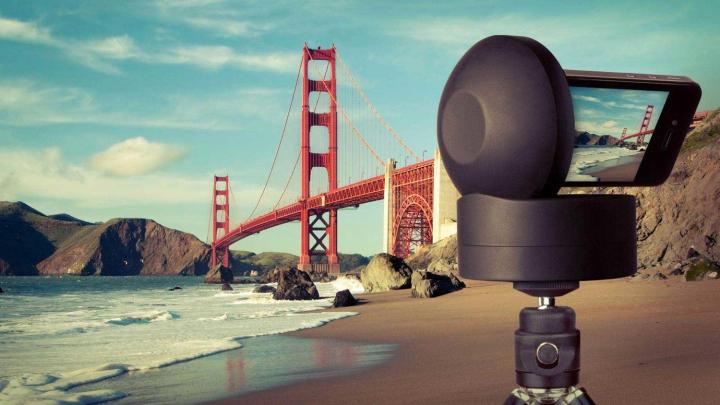
Motrr is also announcing compatibility with a new app called Golem. With this app, you can control a docked iPhone from another iOS device, as well as Android and Web browsers. Since it runs in the background on a host device, you can control it during a videoconference call using Skype, Google Hangouts, etc. So, if there are multiple people during a call, you can pan-and-tilt around the room to focus on whoever is speaking, without interrupting the app or physically turning the device.
Check out our review of the Motrr Galileo smartphone accessory.
Seriously, what is up with all the spherical cameras that have hit the scene lately? Perhaps it’s the fault of Google’s Street View that’s getting people so excited about making their own 360-degree panoramic photos, or because what was once a difficult photographic technique to achieve can now be done in a matter of seconds. Recently we brought you the Panono and the Bublcam, two spherical cameras that are currently running campaigns on Kickstarter and Indiegogo. But at more than $400, both Panono and Bublcam are a bit more expensive than most people can afford. If you have an iPhone 4S or newer, however, there’s a less expensive option for shooting 360-degree images, by using a free app called Sphere with the Galileo dock from Motrr.
The Galileo is a robotic dock that automatically pans and swivels your iPhone around, while your iPhone records the image using an app made my Sphere. It comes in two versions: one with Bluetooth and another with a 30-pin dock. Here’s how it works. You’ll need to position the Galileo with at least 4 feet of space around it. You can set it on a table or tripod, but it just needs to be level and steady. The next step is to secure your iPhone to the Galileo, and then swing it 90 degrees. If your iPhone uses the old 30-pin connector, everything should work seamlessly, but you’ll need to utilize the Bluetooth version for iPhones with the Lightning connector (unless you use the 30-pin adapter) or you prefer to go wireless; simply twist the base of the Galileo to initiate pairing. Once you press the start button, the Galileo and Sphere software will begin the recording process.

After it’s done with the stitching process, a successful image will look like the one above. You can preview it or upload to share it, but the only way to view the panoramic image outside of the app is via the Sphere website or an embed code. The Galileo Bluetooth variant and Sphere also supports the fifth-generation iPod Touch, while the 30-pin version supports the iPhone 3GS and fourth-generation iPod Touch.
Both versions of the Galileo cost $150. Sphere isn’t the only app that’s compatible with the Galileo (check this page for all supported apps, like ones for remote security monitoring), but Motrr and Sphere are offering a special price of $127.46 until December 31, 2013.
(This article was originally published on November 19, 2013.)


